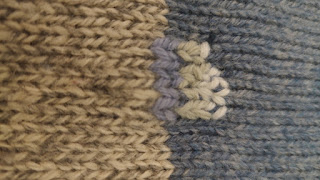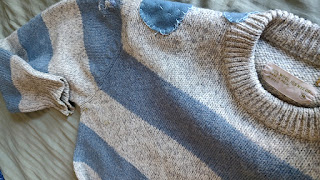I see two types of sewing tutorials online. One comes from highly skilled people They make everything seem easy, but I have enough experience to know it would take me years to achieve their level of proficiency. The other comes from people who actually do crappy work. They also make it look easy, but I have enough experience to know they are not worth emulating. By and large, no one tells you that learning these skills can be difficult. I am here to do just that.
Last winter my spouse showed me a favorite wool sweater that had developed several holes. He wasn't sure if they had been caused by moths or wear and time. I tossed the sweater in my bin of items for mending/upcycling and it sat there for a year.
It caught my eye when I was going through the bin intending to reduce the volume of fabric inside. The sweater was taking up a lot of room. My spouse prefers mending not to be startlingly visible and it seemed like a good opportunity to try Swiss darning for the first time. Swiss darning is a method that duplicates the stitches in the sweater. If you use similar colors it can be relatively invisible.
Using the technique was harder than I anticipated. I struggled. I first attempted to follow the tutorial in the book Modern Mending. I couldn't quite get it to work. I had difficulty with the geometry of the stitching and the fact that the yarn in the sweater had felted and I couldn't clearly see the stitches I needed to duplicate. Then, I went to this Youtube Video on Swiss darning and attempted their way of Swiss darning. I also checked out other online resources. Alas, none improved my technique.
After I had toiled away for several hours, my spouse noticed I was working on his sweater and, said, "I didn't realize that I gave you that sweater to mend." I did manage to close a few holes, but in no instance did my mending stitches actually follow the sweater stitches in the way it was supposed to. I would probably have been better off using a woven darn, which I am more proficient at.
I couldn't use Swiss darning on some of the larger holes near the top of the sweater due to their shape and location and decided to patch them. Even though I know how to patch, this took me a few attempts. To complete these, I used my sewing machine to sew around the hole to keep it from unraveling further. I then used a zig-zag stitch to machine sew on patches cut from fleece scraps The patches puckered and looked really stupid so I undid the machine stitching and then hand-stitched the patches using a blanket stitch.
After all this work, my spouse declared he felt he had to continue wearing the sweater since I had put so much time into fixing it so there was one small victory in all of this.
I will try Swiss darning again in the future and hopefully it will go better next time.




%20v3.png)
%20v3.png)

No comments:
Post a Comment